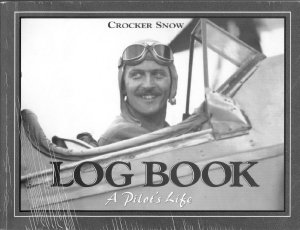This exhibit features photographs relating to Crocker Snow collected by the Massachusetts Aviation Historical Society.
Crocker Snow (1905-1999) was born in Boston to Frederick E. Snow and Lillian (Townsend) Snow. Snow's active engagement in civil and military flying spanned more than seven decades, from the biplane era to the jet age.
His fascination with aviation began at the age of five when his father took him to the Harvard-Boston Aero meet in 1910. Snow was captivated by World War I air aces and the achievements of his oldest brother, Bill, a naval aviator who flew antisubmarine patrols off the French and English coasts.
Mr. Snow's first flight was in October 1922, while a freshman at Harvard. He rode in an open-cockpit Avro biplane flown by his brother, Kick (Kitchell), a pilot in the Massachusetts Air National Guard. "My first flight was all I had dreamed of: sailing effortlessly over the trees at the end of the field, watching the houses shrink and the landscape expand as we climbed". 1
Snow received Massachusetts Pilot License No. 5 in February 1927, signed by Orville Wright. By May he was giving rides in an OX-5 Travel Air biplane. One of Snow's first passengers in his Travel Air biplane was Amelia Earhart. At that time she was a social worker at Denison House, a refuge for the poor in Boston. She wanted to fly over the city to drop leaflets advertising a charity fundraiser and Snow was happy to oblige. Graduating from Harvard University in 1926, spending one year at Harvard Law School, in March 1928 he founded Skyways, one of Boston's first commercial airlines, headquartered at Boston Airport.
He wrote the first comprehensive aeronautical law for Massachusetts in 1939. He became the first director of the newly created Massachusetts Aeronautics Commission.
In 1941 he was called to active duty at the request of Colonel Bob Olds, who was in charge of getting lend-lease airplanes over to Britain. Snow's first job as commanding officer at the North Atlantic Sector of Old's Air Corps Ferrying Command, was to represent the U.S. Army Air Force in construction of airports at Presque isle, Maine, Goose Bay, Labrador, and Bluie West One, Greenland. During this tour of duty he proposed and tested the unescorted delivery of fighter aircraft across the Atlantic.
Snow was placed in command of a B-17 provisional bombardment group which he trained and delivered to the United Kingdom in 1943. In 1944 he was assigned to B-29s and given the 498th Bombardment Group to organize. He was assistant chief of staff under General Rosie O'Donnell, of the 73rd Bomb Wing. He flew with the second B-29 mission to land in the Marianas and in November of 1944 accompanied the 498th in the first B-29 raid against Tokyo. A Citation for Meritorious Service from the 20th Air Force commended his outstanding flying ability and resourcefulness.
After the World War II, he returned to his job as Massachusetts Director of Aeronautics. He was active in aviation, serving as president of the National Association of State Aviation Officials and president of the Harvard College Aviation Foundation, chairman of the Federal Aviation Advisory Commission, director of the National Pilots Association, director of the National Aeronautic Association, chairman of the Navigational Aids and Airspace Committee, chairman of the New England Council Air Transportation Committee, chairman of the New England Conference of State Aviation Officials and consultant to the Airways Modernization Board.
In the early 1970's he was appointed chairman of the President's Aviation Advisory Commission, a panel created by Congress to study the long-range needs of commercial and private aviation.
Mr. Snow flew solo late into his life, operating his modified 1947 single-engine North American Navion, logging more than 900,000 miles in that plane. Alongside his home in Ipswich Massachusetts that he shared with his wife of almost 60 years, Janice (Vaughn-Little), was an airstrip informally known to the Federal Aviation Administration as the Ipswich International Airport.
In 2001 the Smithsonian National Air and Space Museum acquired a large amount of material from the Snow family, according to the September 2002 edition of Smithsonian's Air & Space Magazine. The Smithsonian's Crocker Snow collection consists of approximately 40 cubic feet of material documenting his varied aviation career. These materials include the following types of media: photographs, published materials, audio and videotapes, manuscripts, reports, surveys, propaganda leaflets, correspondence, and scrapbooks. There is quite a bit of material relating to airport planning, specifically Boston Logan Airport and the problems of noise pollution.
Crocker Snow Collection:Smithsonian
1. Snow, Crocker. Log Book A Pilots Life. Washington: Brassey's, 1997.
